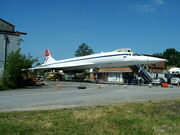
This was a BAe/Aérospatiale Concorde operated by British Aerospace. It first flew on 13th December 1974 from Filton to RAF Fairford. Its main uses were finalising the Concorde design before the other aircraft entered passenger service and certification prior to Concorde entering passenger service. There were some differences between this aircraft and the final production aircraft, such as a thinner fuselage skin. The aircraft was painted in British Airways livery throughout its testing period.It last flew on 24 December 1981 after a total of 1282 hours. Subsequently it was stored in a hangar on the Filton Airfield and was used as a spare parts source by BA for their Concorde fleet. It was sectioned & moved by road in May/June 2004 to the Brooklands museum site in Weybridge, Surrey, where after restoration was opened to the public in the summer of 2006.
There is an unverified story amongst British Aerospace staff that the last flight of the Filton airplane was on a contract to the UK Ministry of Defence, to see if a supersonic jet of that size would be radar visible heading over Iceland and down towards the UK from the West; a test of the country's radar defences against the then-new Tupolev Tu-160 'Blackjack' bomber. However, the flight test logs show the final flights of G-BBDG as being test flights being related to Primary Nozzle Control (PNC) development work, which was a planned post entry into service development area.
After the final flight, it was stored at Filton in a state of semi-airworthiness, where it could be returned to flight in two weeks if required. However this was never required and the aircraft was eventually bought by British Airways as part of a Concorde support buy-out.
The aircraft never entered service with British Airways, instead it was used as a major source of spare parts. A hangar was constructed on the Filton Airport to house the aircraft. Its tail was removed prior to being put in the hangar.
In 1995, another Concorde had its nose damaged in a handling accident at Heathrow airport. British Airways swapped this nose with the nose of the Concorde stored at Filton. As well as losing its nose and tail, other parts were taken, including its engines, landing gear and rear loading door.
Many times the aircraft has been considered for scrapping, but it has always been found to be useful. In 2001, it was used to test reinforced cockpit doors required for all aircraft after the September 11, 2001 terrorist attacks.
When all other Concordes were retired, the Brooklands museum inspected the aircraft and decided to accept it as a museum exhibit. The aircraft was cut up into 3 pieces and transported by road to the Brooklands museum site. The tasks of disassembling and reassembling the aircraft are being carried out by Air Salvage International (ASI). It is currently being restored.
Status[]
Preserved at Brooklands Museum, Weybridge, UK
The three main fuselage parts of the aircraft were housed inside a tent. Work is ongoing every weekend by a group of volunteers from the group at website ConcordeSST.com (the group is always looking for more volunteers to help, as well as donations).
In recent events, the two wings have been re-attached as well as the front fuselage section to the middle section, and the tail and rear section are to be attached soon. The tent has now been removed and the plane is displayed outside.
The group hopes to get the structural rebuild completed by October of this year.
The plane now has its nose reattached as well as its wings (now completely) as well as for the first time in nearly 20 years, she is sitting on Concorde landing gear (instead of slave gear)
Registrations[]
References[]
- Concorde on English Wikipedia, accessed 1 August 2007
- Includes GFDL text taken from G-BBDG on English Wikipedia